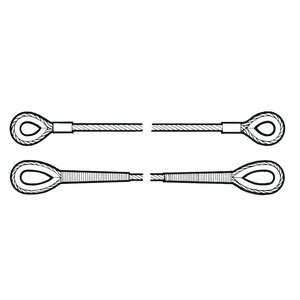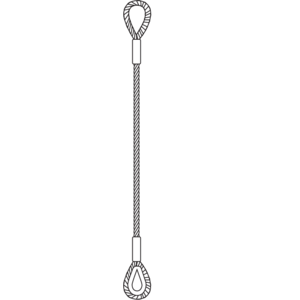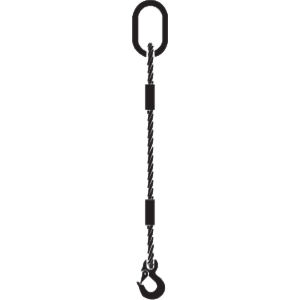Steel Wire Rope Sling Load Chart
Our wire rope sling tables should be used for guidance only. If you are unsure about how to calculate the safe working load for your slings, please contact our training department.
|
Working Load Limits to BS EN 13414-1:2003+A2:2008 |
|||||||||||||
| One-leg sling | Two-leg sling |
Three and four-leg sling | Endless sling | ||||||||||
 |
 |
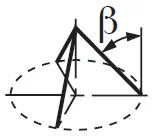 |
 |
||||||||||
| Working Load Limits are based on rope breaking force as defined in BS EN 12385-4. Other Working Load Limits can be calculated using the formula below | |||||||||||||
| Leg Factor | 1 | 1.4 | 1 | 2.1 | 1.5 | 1.6 | |||||||
| t | 0° to 45° | Over 45° to 60° | 0° to 45° | Over 45° to 60° | Choke Hitch | ||||||||
| Nominal Rope Diameter mm | Tensile | Fibre Corded | Steel Corded | Fibre Corded | Steel Corded | Fibre Corded | Steel Corded | Fibre Corded | Steel Corded | Fibre Corded | Steel Corded | Fibre Corded | Steel Corded |
| 8 | 1960 N/mm² | 0.76 | 0.82 | 1.06 | 1.15 | 0.76 | 0.82 | 1.6 | 1.72 | 1.14 | 1.23 | 1.22 | 1.31 |
| 9 | 1960 N/mm² | 0.96 | 1.04 | 1.35 | 1.45 | 0.96 | 1.04 | 2.02 | 2.18 | 1.44 | 1.56 | 1.54 | 1.66 |
| 10 | 1960 N/mm² | 1.19 | 1.28 | 1.66 | 1.79 | 1.19 | 1.28 | 2.49 | 2.69 | 1.78 | 1.92 | 1.9 | 2.05 |
| 11 | 1960 N/mm² | 1.44 | 1.55 | 2.01 | 2.17 | 1.44 | 1.55 | 3.02 | 3.25 | 2.16 | 2.32 | 2.3 | 2.48 |
| 12 | 1960 N/mm² | 1.71 | 1.84 | 2.39 | 2.57 | 1.71 | 1.84 | 3.59 | 3.85 | 2.56 | 2.75 | 2.73 | 2.94 |
| 13 | 1960 N/mm² | 2 | 2.17 | 2.8 | 3.03 | 2 | 2.17 | 4.2 | 4.55 | 3 | 3.25 | 3.2 | 3.47 |
| 14 | 1960 N/mm² | 2.33 | 2.51 | 3.26 | 3.52 | 2.33 | 2.51 | 4.9 | 5.28 | 3.5 | 3.77 | 3.73 | 4.02 |
| 16 | 1960 N/mm² | 3.05 | 3.29 | 4.27 | 4.6 | 3.05 | 3.29 | 6.4 | 6.9 | 4.57 | 4.93 | 4.88 | 5.26 |
| 18 | 1960 N/mm² | 3.85 | 4.15 | 5.4 | 5.81 | 3.85 | 4.15 | 8.09 | 8.71 | 5.78 | 6.22 | 6.17 | 6.64 |
| 20 | 1960 N/mm² | 4.75 | 5.12 | 6.66 | 7.17 | 4.75 | 5.12 | 9.98 | 10.75 | 7.13 | 7.68 | 7.61 | 8.19 |
| 22 | 1960 N/mm² | 5.75 | 6.2 | 8.04 | 8.69 | 5.75 | 6.2 | 12.06 | 13.03 | 8.62 | 9.31 | 9.19 | 9.93 |
| 24 | 1960 N/mm² | 6.85 | 7.38 | 9.58 | 10.33 | 6.85 | 7.38 | 14.38 | 15.5 | 10.27 | 11.07 | 10.95 | 11.81 |
| 26 | 1960 N/mm² | 8.02 | 8.66 | 11.23 | 12.13 | 8.02 | 8.66 | 16.84 | 18.19 | 12.03 | 13 | 12.83 | 13.86 |
| 28 | 1960 N/mm² | 9.31 | 10.04 | 13.03 | 14.06 | 9.31 | 10.04 | 19.54 | 21.08 | 13.96 | 15.06 | 14.89 | 16.06 |
| 32 | 1770 N/mm² | 12.15 | 13.12 | 17.01 | 18.37 | 12.15 | 13.12 | 25.52 | 27.56 | 18.23 | 19.69 | 19.44 | 21 |
| 36 | 1770 N/mm² | 15.38 | 16.59 | 21.53 | 23.23 | 15.38 | 16.59 | 32.3 | 34.84 | 23.07 | 24.89 | 24.61 | 26.55 |
| 40 | 1770 N/mm² | 19.09 | 20.56 | 26.72 | 28.78 | 19.09 | 20.56 | 40.09 | 43.17 | 28.63 | 30.84 | 30.54 | 32.89 |
| 44 | 1770 N/mm² | 22.94 | 24.78 | 32.12 | 34.69 | 22.94 | 24.78 | 48.18 | 52.04 | 34.42 | 37.17 | 36.71 | 39.65 |
| 48 | 1770 N/mm² | 27.35 | 29.55 | 38.29 | 41.37 | 27.35 | 29.55 | 57.43 | 62.06 | 41.02 | 44.33 | 43.76 | 47.28 |
| 52 | 1770 N/mm² | 32.12 | 34.69 | 44.97 | 48.57 | 32.12 | 34.69 | 67.45 | 72.85 | 48.18 | 52.04 | 51.39 | 55.51 |
| 56 | 1770 N/mm² | 37.26 | 40.2 | 52.16 | 56.28 | 37.26 | 40.2 | 78.25 | 84.41 | 55.89 | 60.3 | 59.62 | 64.32 |
| 60 | 1770 N/mm² | 42.77 | 46.07 | 59.87 | 64.5 | 42.77 | 46.07 | 89.81 | 96.75 | 64.15 | 69.11 | 68.43 | 73.71 |
Typical Steel Wire Rope Sling Arrangements
When single leg slings are used either alone or in pairs, the Safe Working Load (SWL) can be affected.
Some examples are given here.
Cradle Sling
Lifting coils, steel strip, etc.
Basket Hitch SWL = 1.4 x WLL of sling
Protect Rope from sharp corners.
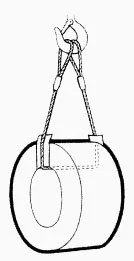
Cradle Slings
Lifting boilers and packaging cases, etc.
Double Basket Hitch
SWL = 2.1 x WLL of single sling.
A basket hitch should only be used when the sling is passed through part of the load and the load is balanced on the sling.
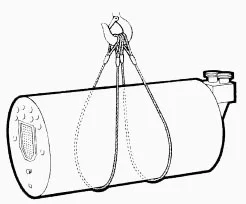
Choke Slings
Method using a single sling in place of an endless sling where a ‘bight’ is required.
Double and Choked.
SWL = 1.6 x WLL of sling.
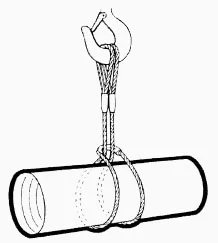
Combination Slings
Timber steel sheets and packing cases, etc.
N.B. Maximum angle between legs is 90º
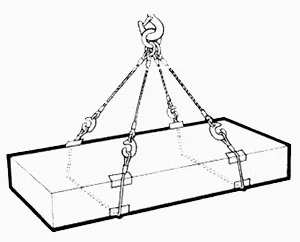
Reeving Slings
Lifting tubes, bars and rods, etc. Double Choke Hitch SWL = 1.4 x WLL of single sling.
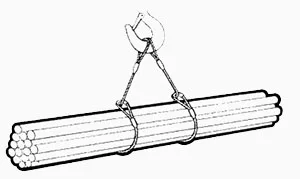
Double Wrap Slings
Note how the double wrap grips the load and helps to prevent it from slipping sideways out of the slings.
Double Wrap Basket Hitch SWL = 2.1 x WLL of single sling.

Working Load Limits & Safe Working Loads
The working load limits of slings made from general engineering ropes to BS EN 12385-4 should conform to BS EN 13414-1: 2003.
Note that the working load limits shown are based on the assumption that soft-eyes of single-part slings are used over bearing points of not less than twice the normal diameter of the rope. All sling ropes must be ordinary lay. The Safe Working Load will normally be equal to the Working Load Limit but in some circumstances it may be less e.g. If the sling is used in choke hitch SWL=WLL x 0.8 .BS EN 13414-1 covers only those sling assemblies that have legs of equal nominal length, diameter, construction and tensile grade. While sling assemblies with legs of unequal length may be made up generally in accordance with the requirements of BS EN 13414-1, it must be stressed that their rating requires special consideration by a competent person.
Caution
In all cases, where hooks or shackles are used, the WLL of the hooks and shackles shall not be less than that of the leg to which they are attached.
Safety recommendations
When using multi-leg sling assemblies, remember that increasing the angles between the legs will increase the load in each leg. Examine all slings before use, and discard any that are defective. Slings that are found to be unfit for use should be destroyed by cutting them up, not put on a refuse dump. ‘Hooking back’ to the leg of a sling is not recommended.
The Safe Working Load of slings is affected by the method of usage. Check that the crane hook is positioned over the load's centre of gravity to prevent swinging when the load is being raised. Correct signals, according to the recognised code, should be given to the crane driver. The signals must be given by the person responsible for the lift and nobody else.
Keep wire rope slings away from welding and flame-cutting operations. The Law requires that all lifting tackle must be examined by a competent person at regular intervals. This includes the wire rope slings. Slingers should not stow away slings and regard them as their own private property, as this could lead to them being overlooked at inspection time.
Certex can manufacture slings to DNV 2-7.1 in our approved facility in Montrose.
